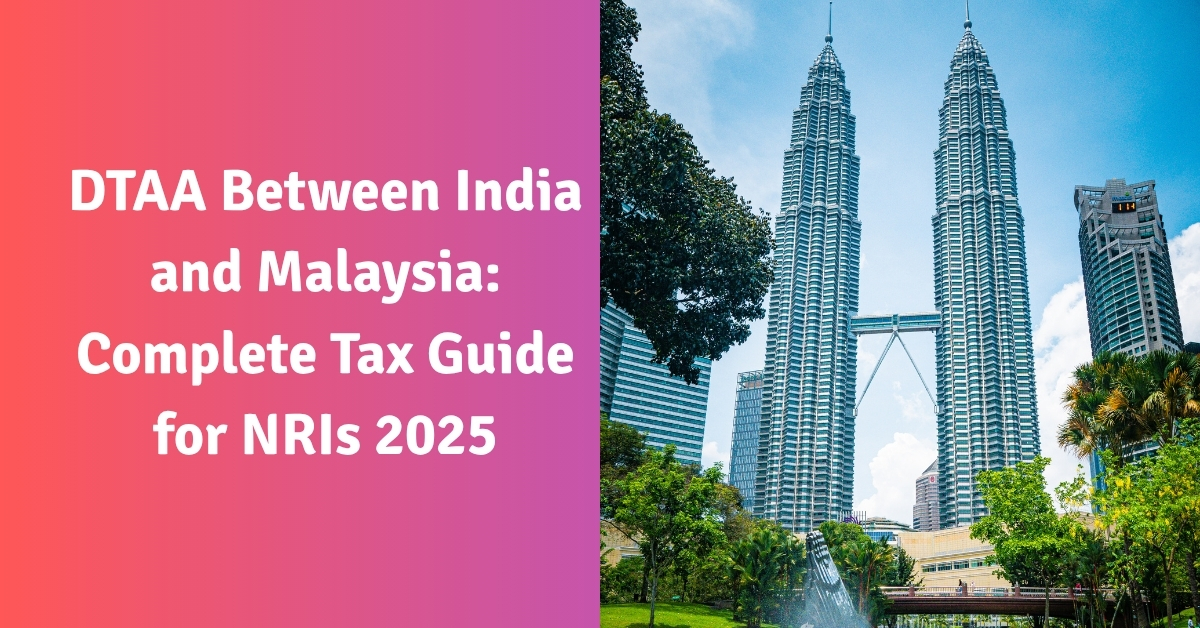DTAA Between India and Malaysia: Complete Tax Guide for NRIs 2025

For NRIs, paying taxes in both India and Malaysia on the same income is like paying for the same meal twice. It can really erode your savings and investment opportunities, especially when wealth accumulation is across borders. However, the Double Taxation Avoidance Agreement (DTAA) between India and Malaysia is there to protect you from paying double tax on the same earnings, and can allow you to maximize your earning potential in the most economically vibrant place in Southeast Asia.
With more than 2 million Indians living in Malaysia and a strong economy across various sectors such as technology, manufacturing, and services, this DTAA can help you save thousands of dollars a year. From specific withholding rates to various tax planning and optimisation opportunities, let us examine the basic aspects of this treaty and put you on the right track to organise your cross-border financial position and build wealth.
What is the India-Malaysia DTAA and Why It’s Your Financial Advantage
The Double Taxation Avoidance Agreement (DTAA) between India and Malaysia has been in effect since 1976, and has undergone multiple updates over the years to represent modern economic realities. It is one of the longest standing tax treaties and the most comprehensive tax treaty in the region. The bilateral agreement removes the burden of double taxation of income by residents of either country; thus it makes Malaysia an appealing place for Indian professionals across many sectors to consider relocation.
The DTAA provides residents of either country reduced tax rates on various forms of income and the assurance that they will not pay tax twice on the same income. The tax treaty covers all types of income including employment income, business profits, dividends, interest, royalties, and capital gains income. In other words, an Indian professional can be sure that their financial activities are comprehensively covered when working, or even investing, income across the two countries.
Furthermore, Malaysia’s geographical position as the gateway into Southeast Asia economic integration, in conjunction with a business-friendly environment and protection under the DTAA, makes for a favourable climate for Indian professionals and entrepreneurs to operate within. While the treaty is based on source-based taxation principles, it also provides you some relief or exemptions from taxation that can significantly reduce your tax obligations in total.
Interesting fact: Malaysia is home to one of the largest Indian diaspora in the world and the India-Malaysia DTAA has been a huge enabling tool that contributes to seamless business and investment of billions of dollars each year between the two countries.
How to Determine Your DTAA Eligibility and Strategic Benefits
The process of claiming DTAA benefits is clearly outlined in three simple steps that will change your tax planning approach:
- Determine your standard tax liability under the Indian Income Tax Act.
- Determine your reduced tax liability under the India-Malaysia DTAA.
- Select the option that results in the maximum monetary benefit (utilizing the Treaty Override mechanism under Section 90(2) of the Indian Income Tax Act).
Eligibility depends on your establishment of Malaysian tax residency through either physical presence of at least 182 days in Malaysia in a calendar year or having Malaysia as your primary residence. Upon establishment of residency, one is entitled to very significant benefits such as a reduced withholding tax, exemptions on certain income sources, and full protection against double taxation.
For instance, if you are a resident of Malaysia, dividend income paid by an Indian company is subject to just 10% withholding tax versus a higher domestic withholding tax. Interest income qualifies for preferential tax and technical service fee rates are capped at competitive rates compared to standard Indian tax.
The general benefit is more significant due to Malaysia’s territorial tax system where income sourced outside of Malaysia is not subject to Malaysian tax; thus, provided the income is remitted to Malaysia after 12 months, you may accumulate wealth to be taxed in Malaysia at a later rate.
Essential Documents for Claiming Your DTAA Benefits
To claim DTAA benefits for the 2025 tax year and beyond, you need to obtain the below documents – missing any of these means you will pay substantially more tax:
- Tax Residency Certificate (TRC): This is a compulsory certificate that you will need to obtain from Malaysia’s Inland Revenue Board (LHDN) confirming that you are a tax resident in Malaysia.
- Form 10F: This is a mandatory declaration form that must be filed by Indian tax authorities for everything that you claimed regarding treaty benefits.
- PAN Card: A PAN card is essential in India for any tax or investment activity.
- Self-declaration: This is a formal declaration confirming your right to obtain DTAA benefits in India and that you complied with all the rules.
If you cannot provide the proper documentation to establish your residency status in Malaysia, and, particularly the TRC and Form 10F, you will pay the non-treaty default rates applicable to withholding taxes where paying substantially more. For instance, if you earn interest income from Indian sources, the tax department may impose a 30.9% TDS instead of the preferable rate of 10% as per the DTAA. Similarly, your dividend payments may be subject to a substantially higher withholding tax without treaty protection.
Pro Tip: LHDN normally completes TRC applications in a period of 21-30 working days, however, during September, and other busy processing times, it may take longer if the TRC application is more complicated. Make sure that you submit your TRC application ahead of your major investment or filing date to cover yourself against potential delays.
You should keep copies of your proof of residency in Malaysia, such as your employment contracts, lease agreements, utility bills, as well as details of your bank statements. This documentation forms part of the TRC application process and provides evidence that you have a real presence in Malaysia.
Malaysia DTAA Tax Rates and Strategic Financial Benefits
The India-Malaysia DTAA offers competitive tax rates that create meaningful savings opportunities across diverse income streams:
| Income Type | DTAA Rate | Standard Indian Rate | Your Potential Savings |
|---|---|---|---|
| Interest Income | 10% | Up to 30.9% | Up to 20.9% reduction |
| Dividend Income | 10% | Higher domestic rates | Significant savings |
| Royalties | 10% | 10% | Consistent treatment |
| Technical Services | 10% | Higher rates possible | Potential savings |
| Business Profits | Source-based | Source-based | Avoid double taxation |
Employment Income: Your salary in Malaysia will only be tax in Malaysia under the DTAA provisions. The Malaysian progressive income tax system (0%-30%) is often tax efficient especially with various allowances/relief available for residents.
Business and Professional Income: Profits are taxed in the one where the business is carried out substantially. Malaysia’s competitive corporate tax rates (standard rate of 24% with incentives) and many pro-business policies should appeal to your Indian entrepreneur perspective as you can set up regional operations.
Investment Income: Interest and dividends are subject to the favorable 10% withholding tax rate making debt investments and dividend stocks attractive. This saves you significantly against standard TDS rates to enhance your investment returns.
Capital Gains: Usually taxed in the country of the asset but Malaysia’s territorial tax system and exemptions can provide additional benefits – helping you with planning and investing.
How to Claim DTAA Benefits Effectively and Optimize Your Strategy
To effectively maximize DTAA benefits, taxpayers need to ensure a well-considered plan and implementation. Following the comprehensive step-by-step process below will maximize these benefits:
- Establish and document eligibility: Establish the taxpayer’s Malaysian tax residency and document residency in Malaysia with supporting documents.
- Obtain required documentation: Obtain a TRC from LHDN and a Form 10F for the Indian tax authorities.
- Liaise with financial institutions: Provide documentation to banks, investment platforms and fund houses to prevent the deduction of higher TDS tax deductions resulting from cross-border income.
- Report foreign income correctly: Report all foreign income and foreign taxes paid on foreign income in Schedule FSI and Schedule TR for your Indian tax filing.
- Maximum relief with Form 67: Submit the Form 67 to claim foreign tax offset after applying their income tax return. This form must be submitted prior your Income Tax Return.
The DTAA benefits of exemption method, credit method and reduced rates can also be combined in various strategic ways to maximize tax benefits.
- Exemption method: Total tax exemption by one of the countries for specific forms of income
- Credit method: Foreign tax paid is offset against domestic tax liability
- Reduced rates: Reduced withholding taxes on the cross-border flows income
More advanced planning could include recognizing and timing your income and remittances in way that relates to Malaysia’s territorial tax systems (as opposed to residence), structuring your investments to maximize the benefits of the treaty agreement, in conjunction with the various tax incentives Malaysia offers related to specific industries, and so on.
Conclusion
The India-Malaysia Double Taxation Avoidance Agreement (DTAA) is an excellent tax optimization option for wealth creation in Asia. The following will be explored: lower withholding tax rate; full double taxation avoidance protection; and business-friendly conditions – all which Malaysia provides. Without a solid grasp of residency obligations, substantiating residency with supportive documentation, and continuing to keep up-to-date on treaty article provisions, all will ultimately be to no avail. Malaysia offers very attractive territorial taxation, it is a very competitive country to run a business in and it has solid DTAA provisions for Indian professionals and Indians investing in Malaysia and looking for sustainability in wealth creation for a very long time. For all clients who are serious about wealth creation, it will be very important to find an experienced financial planner and wealth manager like Prime Wealth for a one-stop solution for NRIs to manage their finances.
FAQs
1. Do I need to pay Indian tax on my Malaysian salary?
Ans- No, if you’re a Malaysian tax resident, your Malaysian employment income is not taxable in India under DTAA provisions.
2. What’s the withholding tax rate on dividends from Indian companies?
Ans- Malaysian residents can claim the reduced 10% rate under DTAA instead of higher standard rates.
3. How long does it take to get a Tax Residency Certificate from Malaysia?
Ans- LHDN typically processes TRC applications within 21-30 working days, longer during peak periods.
4. Can I benefit from Malaysia’s territorial tax system as an Indian?
Ans- Yes, foreign income brought to Malaysia after 12 months may not be taxed, subject to Malaysian tax law conditions.
5. Are capital gains from Indian investments taxable in Malaysia?
Ans- Capital gains are generally taxable where the asset is located, so Indian capital gains remain subject to Indian tax.
6. Can I claim refunds if excess TDS was deducted from my Indian income?
Ans- Yes, file an Indian tax return to claim refunds of excess TDS deducted without DTAA benefits applied.
7. What happens if I lose my Malaysian tax residency status?
Ans- You’ll lose DTAA benefits from the date you cease to be a Malaysian tax resident.
8. Do I need to file tax returns in both countries?
Ans- Depending on your income sources and amounts, you may need to file in both countries to claim benefits and credits.
9. Are technical service fees covered under the DTAA?
Ans- Yes, technical service fees are covered and taxed at the reduced 10% rate under the treaty.
10. Can I use DTAA benefits for real estate rental income?
Ans- Rental income from Indian property remains taxable in India, but you may claim foreign tax credits in Malaysia.



